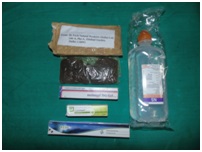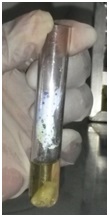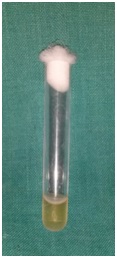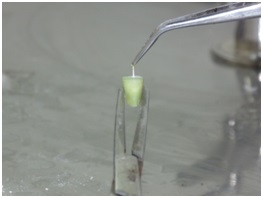Comparative Evaluation of Propolis, Metronidazole with Chlorhexidine, Calcium Hydroxide and Curcuma Longa Extract as Intracanal Medicament Against E.faecalis– An Invitro Study
Shruti Saha1, Rashmi Nair2, Hemant Asrani3
1 Post Graduate Student, Department of Conservative Dentistry and Endodontics, Chhattisgarh Dental College and Research Institiute, Rajnandgaon, Chhattisgarh, India.
2 Reader, Department of Conservative Dentistry and Endodontics, Chhattisgarh Dental College and Research Institiute, Rajnandgaon, Chhattisgarh, India.
3 Professor, Department of Conservative Dentistry and Endodontics, Chhattisgarh Dental College and Research Institiute, Rajnandgaon, Chhattisgarh, India.
NAME, ADDRESS, E-MAIL ID OF THE CORRESPONDING AUTHOR: Dr. Shruti Saha, Post Graduate Student, Department of Conservative, Chhattigarh Dental College, Sundara, Rajnandgaon, Chhattisgarh-491441, India. E-mail : shrutisaha30@gmail.com
Introduction
The increase of potential side effects and safety concerns of conventional medicaments have led to the recent popularity of herbal alternative medications. The herbal products are known for its high antimicrobial activity, biocompatibility, anti-inflammatory and antioxidant properties.
Aim
The purpose of this study was to investigate and compare the effectiveness of Propolis, Metronidazole with Chlorhexidine gel, Curcuma Longa and Calcium Hydroxide for elimination of E.faecalis bacteria in extracted teeth samples.
Materials and Methods
Ninety extracted single rooted intact teeth were taken for the study. Decoronation, removal of apices and chemomechanical preparation was done for all samples. These sterilized samples were then contaminated with pure culture of E.faecalis under laminar flow. The samples were incubated for a period of 21 days. The infected samples were assigned to 5 groups: Group I- Propolis; Group II- Metronidazole with Chlorhexidine gel; Group III- Calcium hydroxide; Group IV- Curcuma Longa; and control group- Saline.
Efficacy of newer intracanal medicaments against E.faecalis were carried out in the samples at the end of 1, 2 & 5 days for each group with the help of colorimeter. Student paired t-test, ANOVA and multiple tukey test were used for statistical analysis.
Results
The value of optical density was statistically significant in all groups when compared to that of control group. Group I (Propolis) produced better antimicrobial efficacy followed by Chlorhexidine Metronidazole combination, Curcuma Longa and Calcium hydroxide.
Conclusion
Within the limitations of this study, it can be concluded that Propolis showed better antimicrobial properties against E.faecalis than other medicaments.
Antimicrobial efficacy, Endodontic treatment, Periradicular diseases
Introduction
The primary objective of endodontic treatment is the elimination of microorganisms from the root canal system [1]. Numerous irritants persists within the canal system due to pathological changes in the dental pulp. The progress of these irritants from the infected canals into the surrounding tissues initiates the formation and perpetuation of peri-radicular lesions and this response is manifested as an immune inflammatory reaction [2].
Studies have shown that microorganisms are mainly responsible for pulpal and periradicular diseases [3]. However, chemomechanical instrumentation is insufficient for complete debridement of the canal system because of its anatomical complexity. Intracanal medication complement the work of instrumentation and irrigation, optimally disinfecting the canal system thus reducing the remaining bacteria and supporting the healing of periapical tissues [4].
E.faecalis, a gram positive and facultative anaerobe is the most prevalent bacteria found in persistent and secondary infections and its prevalence ranges from 24-77% [5]. Considering the resistance of E.faecalis, there is a strong need to investigate intracanal medicament which can totally eliminate it. Calcium hydroxide, the most commonly used intracanal medicament has a high pH that destroys and alters the bacterial lipopolysaccarides in the cell wall. However, it has been shown to be ineffective at killing E.faecalis as this high pH is not maintained [6].
A 2% chlorhexidine in gel or liquid form has shown high efficacy against E.faecalis [7]. Positively charged chlorhexidine molecule interacts with the negatively charged phosphate groups on the bacterial cell wall causing toxic effects [8]. Metronidazole known to be more effective against obligate anaerobic bacteria than aerobic and facultative anaerobic bacteria [9]. A combination of these two medicaments was hypothesized to act in synergistic manner against the bacteria with better efficacy, therefore in this study, a combination was used.
Chemical medicaments are associated with several disadvantages such as antibiotic overuse and misuse, side effects and cytotoxic reaction. Owing to these side effects, herbal and natural products have become more popular. The low toxicity, low microbial resistance, low side effects, low costs and easy availability has made these products very popular [10].
Propolis, rich in flavinoids is known for its antibacterial and healing properties. Study conducted by Ozan F et al., mainly on animals and to a lesser extent on humans, to investigate the use of propolis in dental fields [11].
Curcumin (diferuloyl methane) is a component of turmeric mainly responsible for its biological activities. Curcumin exhibits anti-inflammatory, antioxidant, anticarcinogenic, antiviral, antimicrobial activity [12]. This study was undertaken to evaluate the antibacterial efficacy of Propolis, Calcium hydroxide, Metronidazole with Chlorhexidine gel and Curcuma Longa extract against E.faecalis, compared for 1, 2 and 5 days in extracted teeth samples [Table/Fig-1].
Medicaments used in the study

Materials and Methods
Ninety single-rooted teeth extracted for orthodontic reasons with patent root canals and fully developed root apices were collected from Department of Oral and Maxillofacial Surgery, Chhattisgarh Dental College and Research Institute, Rajnandgaon in 2014. Ethical clearance for the study design was approved by the Ethical committee of Ayush Health Science University, Chhattisgarh. The collected samples were stored in normal saline during the study. The model by Haapasalo & Ørstavik was modified as human teeth were used and cementum was kept intact [13]. A diamond disc was used to decoronate the teeth below the cement enamel junction and to remove the apical part of root so as to obtain 9 mm of middle section of the root. Gates glidden drill no.3 in slow speed handpiece was used to standardize the internal diameter of root canal. The specimens were placed in ultrasonic bath of 17% EDTA for 5 minutes followed by 3% NaOCl for 5 minutes to remove organic and inorganic debris. Traces of chemicals were removed by immersing the dentine specimenin an ultrasonic bath containing distilled water for 5 minutes. All the specimens were sterilized in an autoclave at 121oC for 15 minutes.
Contamination of Specimen: The test organism used for this study was Enterococcus faecalis. The pure culture of freeze dried bacteria was suspended in 5ml of Brain Heart Infusion broth followed by incubation for 4 hours at 37oC. Each of the sterilized sample was inoculated with 10μL inoculums of bacteria using micro pipette and these samples were incubated for a period of 21 days [Table/Fig-2]. This whole procedure was carried out under laminar flow machine to prevent any contamination. During the course of 21 days, samples were transferred into fresh broth after every 48 hours and histological slides were prepared to confirm presence of bacteria.
Sample inoculated with bacteria after incubation period of 21 days

After 21 days, saline irrigation was done to remove the broth from the samples. Dentine was harvested with GG drill no.4, transferred into the broth and incubated [Table/Fig-3]. The optical density of the broth was measured in colorimeter and initial readings were tabulated.
Incubation of dentine shavings harvested from the samples

Antimicrobial Assessment: At the end of 21 days, the sample were sequentially assigned to the following groups (n=18): Group I Propolis (Hitech Natural products India ltd), Group II Metronidazole with Chlorhexidine gel (Metrogyl DG gel forte), Group III Calcium hydroxide (RC Cal), Group IV Curcuma Longa extract (Curenext, Abbott), Group V Saline as control group [Table/Fig-4].
Application of medicaments to the samples

Paraffin wax was used to seal the root end. After the loading of various medicaments, the groups were further divided into three subgroups (n=6) and incubated for different experimental time periods of 1, 2 and 5 days.
Dentine shavings were collected from the specimens after 1st, 2nd and 5th day using Gates Glidden drill no.4. The shavings were collected from the tip of the drills and from paper points. The collected dentine shavings was then transferred into 1 ml of sterile broth and incubated for 24 hours.
Optical density of the broth was calculated using colorimeter. With the growth of microorganisms, the broth became cloudy or turbid from clear fluid. The turbidity was measured using colorimeter. To estimate turbidity, a beam of light was transmitted through a bacterial suspension to a photoelectric cell. The more bacteria, the less light passed. The values of optical density for all the five groups were calculated and tabulated.
Statistical Analysis
The data obtained were subjected to statistical analysis using one way analysis of variance (ANOVA) followed by Multiple Tukey’s test for intergroup comparison to check the bacterial inhibition for each day.
Results
When compared to control group, significance difference was observed between all test groups. With increase in time of application, the antibacterial efficacy also increased with its greatest on the 5th day [Table/Fig-5]. However, Propolis showed the least value of optical density (0.33 ± 0.62) indicating it as the best antibacterial medicament while CHX and metronidazole combination and Curcuma Longa also showed better efficiency than calcium hydroxide.
Mean optical density of the test groups on 1st, 2nd and 5th day
| Propolis | CHX+Metronidazole | Calciumhydroxide | CurcumaLonga | Saline |
|---|
| Day 1 | 0.59 ± 0.10 | 0.57 ± 0.13 | 0.57 ± 0.09 | 0.60 ± 0.10 | 0.80 ± 0.08 |
| Day2 | 0.50 ± 0.09 | 0.51 ± 0.03 | 0.47 ± 0.04 | 0.52 ± 0.04 | 0.80 ± 0.02 |
| Day3 | 0.33 ± 0.02 | 0.34 ± 0.03 | 0.36 ± 0.03 | 0.34 ± 0.032 | 0.84 ± 0.05 |
Discussion
The prime aim of endodontic treatment is the eradication of bacteria and their by-products from the root canal. A favourable outcome of endodontic treatment of teeth with apical periodontitis depends on effective control of root canal infection. Enterococcus faecalis has been the focus of interest in endodontics in recent years because of its high prevalence of occurrence in persistent lesions.
Complex anatomy of root canals and inaccessibility of the instruments makes the disinfection difficult. Therefore it is essential to medicate canals with an effective antibacterial agent after canal preparation. The need for the medication is even greater in the cases of persistent and secondary endodontic infections [14].
E.faecalis was chosen as test organism in this study because of its high prevalence in secondary endodontic infection. The inherent ability of E.faecalis to tolerate starvation, high pH, high salt concentration, biofilm formation and resistance to antibiotic has made its eradication most challenging [15,16].
Awawdeh et al., Victorino et al., showed that propolis was more efficient than calcium hydroxide against E.faecalis while Madhubala et al., showed the efficacy of propolis as 100% against E.faecalis following a 7 days application [17–19]. The mechanism of antibacterial activity for Propolis was better explained by its action on the membrane permeability and membrane potential of E.faecalis thus reducing the resistance of these cells [20]. Propolis was also unaffected by the buffering action of the dentine unlike that of Calcium Hydroxide [16]. In the present study, Propolis showed better antibacterial efficacy compared to CHX Metronidazole combination, Curcuma Longa and Calcium hydroxide as it had the least value of optical density on the 5th day. Thus, confirming that the efficacy of the medicaments increased with the increase in the time of application.
When compared to Calcium hydroxide, CHX and metronidazole combination and Curcuma Longa showed better efficacy as an intracanal medicament. The antibacterial action of CHX on E.faecalis is due to the interaction of its phosphate groups on bacteria cell wall while metronidazole shows good antimicrobial action against anaerobic bacteria like E.faecalis. Hence the combination of the above two medicaments produced additive or synergistic effects.
Curcumin an essential component of Curcuma Longa possess antibacterial, antiapoptotic, antiangiogenic, antineoplastic, antithrombotic, immunomodulatory and wound healing properties [21]. The assembly dynamics of FtsZ protofilaments present in the bacteria play a major role in the formation and functioning of the Z-ring that performs bacterial cytokinesis and cell division. It has been suggested that curcumin inhibits this bacterial cell division by inhibiting the assembly dynamics of FtsZ in the Z-ring [22]. Thus, proving its potent antibacterial activity against E.faecalis. This result is in accordance with the previous study done by Hemanshi et al., who showed that 20% C.longa showed a significant antibacterial efficacy against E.faecalis [23].
Calcium hydroxide showed the least antibacterial efficacy. This is explained by inability of (OH) ion to diffuse in the dentinal tubules at sufficient concentration. The pH homeostasis is maintained by buffering capacity of dentine as well as that of cytoplasm of the bacterial cell through the proton pump mechanism of the cell membrane of E.faecalis wherein the protons are pumped into the cell to lower the internal pH. This result was in accordance with several studies done by Safavi et al.,, Sequiera et al., wherein calcium hydroxide failed to show antibacterial efficacy against E.faecalis [24,25].
Conclusion
Within the limitations of this study, it can be concluded that propolis showed better antimicrobial properties against E.faecalis than other medicaments while metronidazole and chlorhexidine combination and Curcuma Longa were better than calcium hydroxide.
[1]. Walton RE, Ardjmand K, Histopathological evaluation of the presence of bacteria in induced periapical lesions in monkeysJ Endod 1992 18:216-21. [Google Scholar]
[2]. Kakehashi S, Stanley HR, Fitzgerald R, The effects of surgical exposure of dental pulps in germ free and conventional laboratory ratsOral Surg Oral Med Oral Pathol Oral radiol Endod 1965 20:340-49. [Google Scholar]
[3]. Farhad A, Esfahan ZM, Calcium hydroxide: a reviewInt Dent J 2005 55:293-301. [Google Scholar]
[4]. Lee Y, Han SH, Hong SH, Lee JK, Ji H, Kum KY, Antimicrobial efficacy of a polymeric chlorhexidine release device using invitro model of Enterococcus faecalis dentinal tubule infectionJ Endod 2008 34(7):855-58. [Google Scholar]
[5]. Molander A, Reit C, Dahlen G, Kvist T, Microbiological status of root – filled teeth with apical periodontitisInt Endod J 1998 31:1-7. [Google Scholar]
[6]. Haapasalo HK, Siren EK, Waltimo TM, Orstvik T, Haapasalo MP, Inactivation of local root canal by dentine : an in vitro studyInt Endod J 2000 33(2):126-31. [Google Scholar]
[7]. Gomes B, Effectiveness of 2% chlorhexidine gel and calcium hydroxide against Enterococcus faecalis in bovine root dentine invitroInt Endod J 2003 36:267-75. [Google Scholar]
[8]. Lindskog S, Piercs AM, Blomiof L, Chlorhexidine as a root canal medicament for treating inflammatory lesions in the periodontal spaceEndodontics and Dental Traumatology 1998 14:186-90. [Google Scholar]
[9]. Krittikadutta J, Rajamani I, Dorothykalyani AL, Disinfection of dentinal tubule with 2% chlorhexidine, 2% metronidazole, bioactive glass when compared with calcium hydroxide as intracanal medicamentsJ Endod 2007 33(12):1473-76. [Google Scholar]
[10]. Pujar M, Mukandar S, Herbal usage in endodontics – a reviewInternational Journal of Contemporary Dentistry 2011 2(1):34-37. [Google Scholar]
[11]. Ozan F, Polat ZA, Er K, Ozan U, Deger O, Effect of propolis on survival of periodontal ligament cells: new storage media for avulsed teethJ Endod 2007 33:570-73. [Google Scholar]
[12]. Prabhakar AR, Taur S, Hadakar S, Sugandhan S, Comparison of antibacterial efficacy of calcium hydroxide paste, 2% chlorhexidine gel and turmeric extract as an intracanal medicament and their effect on microhardness of root dentine: An invitro studyInternational Journal of Clinical Pediatric Dentistry 2013 6(3):171-77. [Google Scholar]
[13]. Haapasalo M, Orstvik D, Invitro infection and disinfection of dentinal tubulesJ Dent Res 1987 66(8):1375-79. [Google Scholar]
[14]. Menezes MM, Valera MC, Jorge AO, Koga-Ito CY, Camargo CH, Mancini MM, In vitro evaluation of the effectiveness of irrigants and intracanal medicaments on microorganism within the root canalsInt Endod J 2004 37:311-19. [Google Scholar]
[15]. Stuart CH, Schwartz SA, Beeson TJ, Owatz CB, Enterococcus faecalis: its role in root canal treatment failure and current concepts in retreatmentJEndod 2006 32(2):93-98. [Google Scholar]
[16]. Portenier I, Waltimo TMT, Haapasalo M, Enterococcus faecalis: the root canal survivor and star in post treatment diseaseEndodontic Topic 2003 6:135-39. [Google Scholar]
[17]. Awawdeh L, Beitawi M, Hammad M, Effectiveness of propolis and calcium hydroxide as a short term intracanal medicament against Enterococcus faecalis: A laboratory studyAust Endod J 2008 35:52-58. [Google Scholar]
[18]. Victorino FR, Removal efficiency of propolis paste dressing from the root canalJ Appl Oral Sci 2010 18(6):621-24. [Google Scholar]
[19]. Madhubala MM, Srinivasan N, Ahamed S, Comparative evaluation of propolis and triantibiotic mixture as an intracanal medicament against Enterococcus faecalisJ Endod 2011 37(9):1287-89. [Google Scholar]
[20]. Mirzoeva OK, Grishanin RN, Calder PC, Antimicrobial action of propolis and some of its components:the effects on grown, membrane potential and motility of bacteriaMicrobiol Res 1997 152:239-46. [Google Scholar]
[21]. Cikrikci S, Mozioglu E, Yilmaz H, Biological activity of curcuminoids isolated from Curcuma LongaRec Nat Prod 2008 2(1):19-24. [Google Scholar]
[22]. Mandroli PS, Bhat K, An in vitro evaluation of antibacterial action of curcumin against common endodontic bacteriaJournal of Applied Pharmaceutical Science 2013 3(10):106-08. [Google Scholar]
[23]. Kumar H, An invitro evaluation of the antimicrobial efficacy of Curcuma Longa, Tachyspermumammi, chlorhexidine gluconate and calcium hydroxide on Enterococcus faecalisJ Cons Dent 2013 16(2):144-47. [Google Scholar]
[24]. Safavi KE, Spangberg LSW, Langeland K, Root canal dentinal tubule disinfecionJ Endod 1990 16:207-10. [Google Scholar]
[25]. Siqueira JF, Uzeda M, Disinfection by calcium hydroxide pastes of dentinal tubules infected with two obligate and one facultative anaerobic bacteriaJ Endod 1996 22:674-76. [Google Scholar]